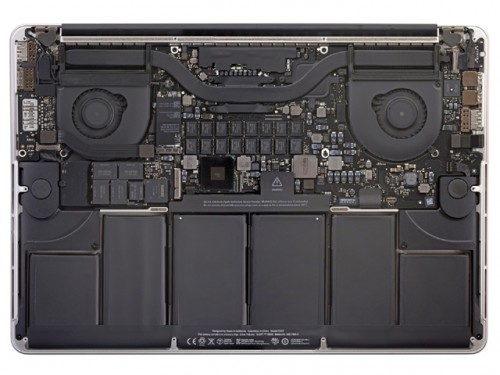You may have followed today’s news via iFixit or Mashable that the new Apple Mac Book Pro with the Retina Display will contain almost no repairable parts. Much like the iPads, I believe, even though there are still spare parts available for those.
I am always blown away by the amount of engineering found in Apple products, especially compared to the “modular” competitors (i.e. Dell, Lenovo and HP) whose spare parts are still available on eBay & Co. long after their laptops are out of production. Parts fail, displays break, rubberised touchpad buttons wear off, hinges and keyboards wear out and so on.
 the opened new MacBookPro Retina, image via iFixit.com
the opened new MacBookPro Retina, image via iFixit.com
Not so the new MBP Retina (pictured above) which seems to have no repairable parts at all. In case of a hardware fault, most customers are supposed to return it to Apple. My DIY-heart of course yells at this (“I will fix it anyways!”), but I also understand that this step is part of their marketing and quality management.
The battery? Well, as far as I understand there are two main reasons why it would need to be replaced: heat and constant overcharging. And as far as I am informed, this overcharging is prevented by a circuit otherwise only found with previous ThinkPads from IBM/Lenovo. So it seems like there is no reason to have the battery replaced during the first 2-3 years of use.
Ok, and then? What happens after 2-3 years of use when the next generation of MacBooks is waiting on the shelves? That’s the time when most gadgets are turned in for repairs, I think. Repairs that are expensive because they often won’t be covered by a manufacturers warranty.
Here’s the idea
Given that Apple already introduced this “no maintenance required – if broken, we’ll fix it for you”-concept in the past but only nailed it with the almost non-repairable iPad, Apple customers are assumed to be mainly users – instead of tinkerers*. So, obviously, many customers are already used to this concept and would have no problems exchanging their beloved machines for a new one (except for extra costs where applicable).
Now, instead of selling the hardware, the idea would be to only lease out the hardware to customers for a given time frame of 2-3 yrs and then have them return it to Apple.
The benefits
- Apple could start using better / more expensive materials because all hardware is returned to the manufacturer, remains in a technical loop
- A recycling is possible = less material costs, less dependency on rare earth metals from China & Co
- Apple benefits from real world scenarios, has complete control over usage (I know they like that), design teams can pick up on this for further improvements
- Customers won’t have to cough up USD 1000-3000 at once but pay monthly installments instead (by default!)
- Apple has the financial resources to take this “risk”
- Customers get a new machine every 2-3 yrs, consistent market
- User data is more attractive than hardware: care for home folder, everything backed up in the Cloud
- Software is the bigger market than hardware (I think): make them stick to an OS and then provide them with apps (see the iPhone – works like a charm on iOS!)
- Customers won’t have to worry about the hardware as it will be replaced
Heck, if Apple doesn’t do that, someone else should do it. Not the leasing as such but this whole model of ownership – because, after all, with Apple’s latest design we are just users, not tinkerers anymore. Just as we stopped buying complete music albums and go for single mp3 tracks instead, this concept of “ownership” is totally different to the one we had in the past. Maybe not for you or me, but for those a few years younger than us.
I believe that Apple has the right approach and I would like to encourage them going a step further with this Cradle-to-Cradle-inspired proposal. It’s all about having a sound business and still doing good.
*tinkerers: most Apple users I know bought their Apple products because they don’t want to mess with the system or any components. So while they may just be into that DIY-stuff as I am, their Apple products often remain as they are. Not because they couldn’t, but because they don’t want to.
(this Mashable post on G+ inspired me to this blog post)

New blog post: Hey Apple, this is your chance! http://t.co/SonxEEJE
Hey Apple, this is your chance! http://t.co/FBFVhMuU